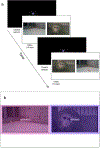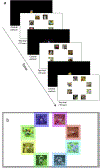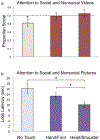Social touch alters newborn monkey behavior
- PMID: 31521911
- PMCID: PMC6878204
- DOI: 10.1016/j.infbeh.2019.101368
Social touch alters newborn monkey behavior
Abstract
In humans, infants respond positively to slow, gentle stroking-processed by C-tactile (CT) nerve fibers-by showing reductions in stress and increases in eye contact, smiling, and positive vocalizations. More frequent maternal touch is linked to greater activity and connectivity strength in social brain regions, and increases children's attention to and learning of faces. It has been theorized that touch may prime children for social interactions and set them on a path towards healthy social cognitive development. However, less is known about the effects of touch on young infants' psychological development, especially in the newborn period, a highly sensitive period of transition with rapid growth in sensory and social processing. It remains untested whether newborns can distinguish CT-targeted touch from other types of touch, or whether there are benefits of touch for newborns' social, emotional, or cognitive development. In the present study, we experimentally investigated the acute effects of touch in newborn monkeys, a common model for human social development. Rhesus macaques (Macaca mulatta), like humans, are highly social, have complex mother-infant interactions with frequent body contact for the first weeks of life, making them an excellent model of infant sociality. Infant monkeys in the present study were reared in a neonatal nursery, enabling control over their early environment, including all caregiver interactions. One-week-old macaque infants (N = 27) participated in three 5-minute counter-balanced caregiver interactions, all with mutual gaze: stroking head and shoulders (CT-targeted touch), stroking palms of hands and soles of feet (Non-CT touch), or no stroking (No-touch). Immediately following the interaction, infants watched social and nonsocial videos and picture arrays including faces and objects, while we tracked their visual attention with remote eye tracking. We found that, during the caregiver interactions, infants behaved differently while being touched compared to the no-touch condition, irrespective of the body part touched. Most notably, in both touch conditions, infants exhibited fewer stress-related behaviors-self-scratching, locomotion, and contact time with a comfort object-compared to when they were not touched. Following CT-targeted touch, infants were faster to orient to the picture arrays compared to the other interaction conditions, suggesting CT-targeted touch may activate or prime infants' attentional orienting system. In the No-touch condition infants attended longer to the nonsocial compared to the social video, possibly reflecting a baseline preference for nonsocial stimuli. In contrast, in both touch conditions, infants' looked equally to the social and nonsocial videos, suggesting that touch may influence the types of visual stimuli that hold infants' attention. Collectively, our results reveal that newborn macaques responded positively to touch, and touch appeared to influence some aspects of their subsequent attention, although we found limited evidence that these effects are mediated by CT fibers. These findings suggest that newborn touch may broadly support infants' psychological development, and may have early evolutionary roots, shared across primates. This study illustrates the unique insight offered by nonhuman primates for exploring early infant social touch, revealing that touch may positively affect emotional and attentional development as early as the newborn period.
Keywords: CT fibers; Face perception; Infant behavior; Neonate; Sociability; Social attention; Tactile.
Copyright © 2019 Elsevier Inc. All rights reserved.
Conflict of interest statement
Figures




Similar articles
-
Human and monkey infant attention to dynamic social and nonsocial stimuli.Dev Psychobiol. 2020 Sep;62(6):841-857. doi: 10.1002/dev.21979. Epub 2020 May 18. Dev Psychobiol. 2020. PMID: 32424813 Free PMC article.
-
Psychophysiological and Visual Behavioral Responses to Faces Associated with Affective and Non-affective Touch in Four-month-old Infants.Neuroscience. 2021 Jun 1;464:67-78. doi: 10.1016/j.neuroscience.2020.07.053. Epub 2020 Aug 6. Neuroscience. 2021. PMID: 32771501
-
Infants discriminate the source of social touch at stroking speeds eliciting maximal firing rates in CT-fibers.Dev Cogn Neurosci. 2019 Apr;36:100639. doi: 10.1016/j.dcn.2019.100639. Epub 2019 Mar 19. Dev Cogn Neurosci. 2019. PMID: 30903992 Free PMC article.
-
The developmental origins of naïve psychology in infancy.Adv Child Dev Behav. 2009;37:55-104. doi: 10.1016/s0065-2407(09)03702-1. Adv Child Dev Behav. 2009. PMID: 19673160 Review.
-
Neuroendocrine mechanisms involved in the physiological effects caused by skin-to-skin contact - With a particular focus on the oxytocinergic system.Infant Behav Dev. 2020 Nov;61:101482. doi: 10.1016/j.infbeh.2020.101482. Epub 2020 Sep 10. Infant Behav Dev. 2020. PMID: 32919112 Review.
Cited by
-
Changes in social environment impact primate gut microbiota composition.Anim Microbiome. 2024 Nov 13;6(1):66. doi: 10.1186/s42523-024-00355-y. Anim Microbiome. 2024. PMID: 39538341 Free PMC article.
-
Endogenous Control and Reward-based Mechanisms Shape Infants' Attention Biases to Caregiver Faces.Dev Psychobiol. 2024 Sep;66(6):e22521. doi: 10.1002/dev.22521. Dev Psychobiol. 2024. PMID: 38952248 Free PMC article.
-
Affective touch in the context of development, oxytocin signaling, and autism.Front Psychol. 2022 Nov 23;13:967791. doi: 10.3389/fpsyg.2022.967791. eCollection 2022. Front Psychol. 2022. PMID: 36506943 Free PMC article. Review.
-
A systematic review and multivariate meta-analysis of the physical and mental health benefits of touch interventions.Nat Hum Behav. 2024 Jun;8(6):1088-1107. doi: 10.1038/s41562-024-01841-8. Epub 2024 Apr 8. Nat Hum Behav. 2024. PMID: 38589702 Free PMC article.
-
Oxytocin but not naturally occurring variation in caregiver touch associates with infant social orienting.Dev Psychobiol. 2022 Sep;64(6):e22290. doi: 10.1002/dev.22290. Dev Psychobiol. 2022. PMID: 35748632 Free PMC article.
References
-
- Bales KL, Witczak LR, Simmons TC, Savidge LE, Rothwell ES, Rogers FD, Manning RA, Heise MJ, Englund M, & del Razo RA (2018). Social touch during development: Long-term effects on brain and behavior. Neuroscience & Biobehavioral Reviews, 95, 202–219. doi: 10.1016/j.neubiorev.2018.09.019 - DOI - PubMed
Publication types
MeSH terms
Grants and funding
LinkOut - more resources
Full Text Sources
Medical

